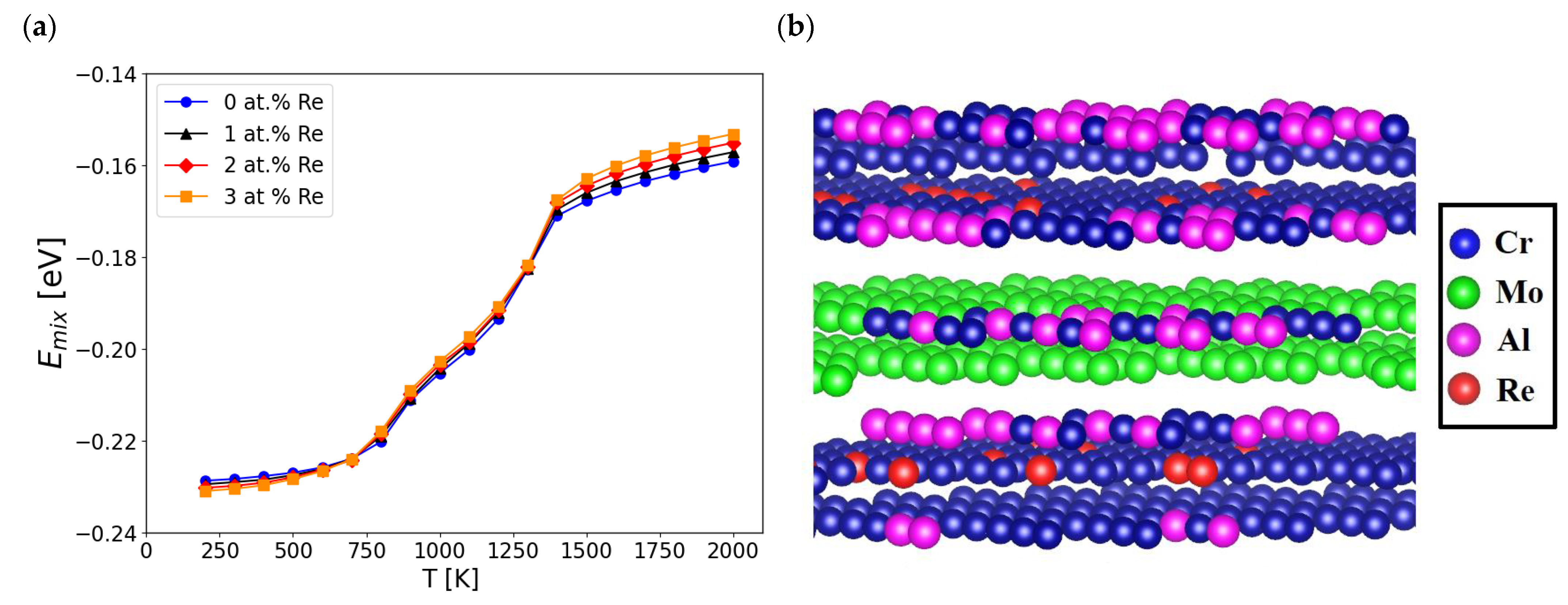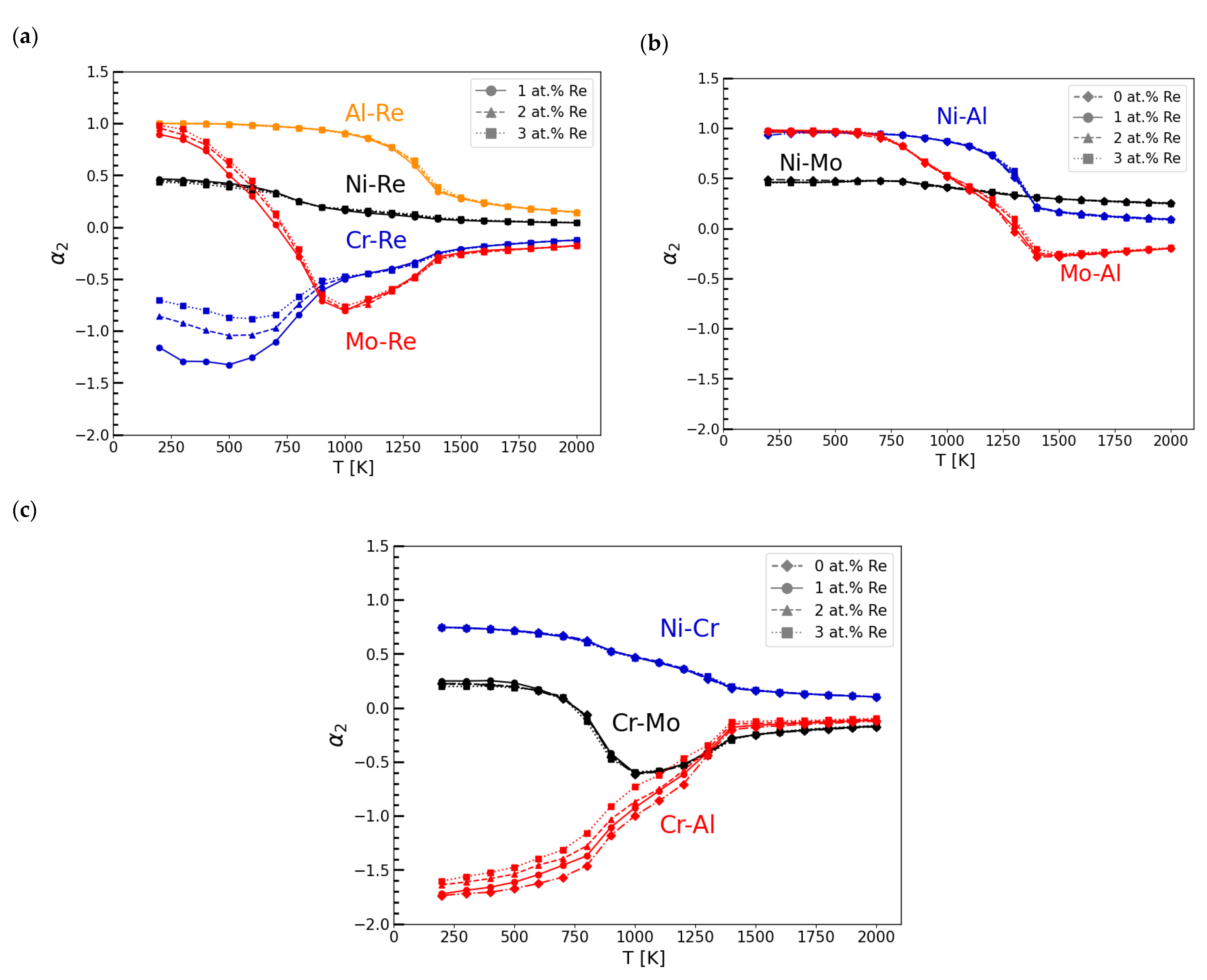Effect of the Addition of Re on the Microstructure and Phase Composition of Haynes 282: Ab Initio Modelling and Experimental Investigation of Additively Manufactured Specimens
Abstract
1. Introduction
2. Materials and Methods
3. Results and Discussion
3.1. Ab-Initio Modelling
3.2. XRD Results and Comparison with MC Simulations
4. Conclusions
Author Contributions
Funding
Institutional Review Board Statement
Informed Consent Statement
Data Availability Statement
Acknowledgments
Conflicts of Interest
References
- Pike, L.M. Development of a Fabricable Gamma-Prime (γ′) Strengthened Superalloy. In Proceedings of the International Symposium on Superalloys, Champion, PA, USA, 14–18 September 2008; pp. 191–200. [Google Scholar] [CrossRef]
- Kruger, K.L. HAYNES 282 Alloy. In Materials for Ultra-Supercritical and Advanced Ultra-Supercritical Power Plants; Woodhead Publishing: Cambridge, UK, 2017; pp. 511–545. ISBN 9780081005583. [Google Scholar]
- Liu, C.P.; Zhang, X.N.; Ge, L.; Liu, S.H.; Wang, C.Y.; Yu, T.; Zhang, Y.F.; Zhang, Z. Effect of Rhenium and Ruthenium on the Deformation and Fracture Mechanism in Nickel-Based Model Single Crystal Superalloys during the in-Situ Tensile at Room Temperature. Mater. Sci. Eng. A 2017, 682, 90–97. [Google Scholar] [CrossRef]
- Huang, M.; Zhu, J. An Overview of Rhenium Effect in Single-Crystal Superalloys. Rare Met. 2016, 35, 127–139. [Google Scholar] [CrossRef]
- Yu, X.X.; Wang, C.Y.; Zhang, X.N.; Yan, P.; Zhang, Z. Synergistic Effect of Rhenium and Ruthenium in Nickel-Based Single-Crystal Superalloys. J. Alloys Compd. 2014, 582, 299–304. [Google Scholar] [CrossRef]
- Neumeier, S.; Pyczaky, F.; Göken, M. Influence of Rhenium and Ruthenium on the Local Mechanical Properties of the γ and γ′ Phases in Nickel-Base Superalloys. Philos. Mag. 2011, 91, 4187–4199. [Google Scholar] [CrossRef]
- Heckl, A.; Rettig, R.; Singer, R.F. Solidification Characteristics and Segregation Behavior of Nickel-Base Superalloys in Dependence on Different Rhenium and Ruthenium Contents. Metall. Mater. Trans. A Phys. Metall. Mater. Sci. 2010, 41, 202–211. [Google Scholar] [CrossRef]
- Wu, X.; Makineni, S.K.; Liebscher, C.H.; Dehm, G.; Rezaei Mianroodi, J.; Shanthraj, P.; Svendsen, B.; Bürger, D.; Eggeler, G.; Raabe, D.; et al. Unveiling the Re Effect in Ni-Based Single Crystal Superalloys. Nat. Commun. 2020, 11, 389. [Google Scholar] [CrossRef]
- Zhang, J.; Huang, T.; Lu, F.; Cao, K.; Wang, D.; Zhang, J.; Zhang, J.; Su, H.; Liu, L. The Effect of Rhenium on the Microstructure Stability and γ/γ′ Interfacial Characteristics of Ni-Based Single Crystal Superalloys during Long-Term Aging. J. Alloys Compd. 2021, 876, 160114. [Google Scholar] [CrossRef]
- Zhang, Z.; Wen, Z.; Yue, Z. Effects of Re on Microstructure Evolution of Nickel-Based Single Crystal Superalloys. Appl. Phys. A Mater. Sci. Process 2020, 126, 680. [Google Scholar] [CrossRef]
- Xia, W.; Zhao, X.; Yue, Q.; Xuan, W.; Pan, Q.; Wang, J.; Ding, Q.; Bei, H.; Zhang, Z. Competitive Deformation Induced by TCP Precipitation and Creep Inconsistency on Dendritic Structures in a Nickel-Based Single Crystal Superalloy Crept at High Temperatures. Mater. Charact. 2022, 187, 111855. [Google Scholar] [CrossRef]
- Petrushin, N.; Elyutin, E.S.; Nazarkin, R.M.; Pakhomkin, S.I.; Kolodochkina, V.G.; Fesenko, T.; Dzhioeva, E.S. Segregation of Alloying Elements in Directionally Solidified Re–Ru-Containing Ni-Based Superalloys. Inorg. Mater. Appl. Res. 2016, 7, 824–831. [Google Scholar] [CrossRef]
- Liu, E.; Guan, X.; Zheng, Z. Effect of Rhenium on Solidification and Segregation of Nickel-Based Superalloy. Rare Met. 2011, 30, 320–322. [Google Scholar] [CrossRef]
- Lopez-Galilea, I.; Koßmann, J.; Kostka, A.; Drautz, R.; Mujica Roncery, L.; Hammerschmidt, T.; Huth, S.; Theisen, W. The Thermal Stability of Topologically Close-Packed Phases in the Single-Crystal Ni-Base Superalloy ERBO/1. J. Mater. Sci. 2016, 51, 2653–2664. [Google Scholar] [CrossRef]
- Sun, N.; Zhang, L.; Li, Z.; Shan, A. The Effect of Microstructure on the Creep Behavior of a Low Rhenium-Containing Single Crystal Nickel-Based Superalloy. Mater. Sci. Eng. A 2014, 606, 175–186. [Google Scholar] [CrossRef]
- Sun, N.; Zhang, L.; Li, Z.; Shan, A. Effect of Heat-Treatment on Microstructure and High-Temperature Deformation Behavior of a Low Rhenium-Containing Single Crystal Nickel-Based Superalloy. Mater. Sci. Eng. A 2014, 606, 417–425. [Google Scholar] [CrossRef]
- Eriş, R.; Akdeniz, M.V.; Mekhrabov, A.O. The Site Preferences of Transition Elements and Their Synergistic Effects on the Bonding Strengthening and Structural Stability of γ′-Ni3Al Precipitates in Ni-Based Superalloys: A First-Principles Investigation. Metall. Mater. Trans. A Phys. Metall. Mater. Sci. 2021, 52, 2298–2313. [Google Scholar] [CrossRef]
- Matuszewski, K.; Müller, A.; Ritter, N.; Rettig, R.; Kurzydłowski, K.J.; Singer, R.F. On the Thermodynamics and Kinetics of TCP Phase Precipitation in Re- and Ru- Containing Ni-Base Superalloys. Adv. Eng. Mater. 2015, 17, 1127–1133. [Google Scholar] [CrossRef]
- Ching, W.Y.; San, S.; Zhou, C.; Sakidja, R. Ab Initio Simulation of Structure and Properties in Ni-Based Superalloys: Haynes282 and Inconel740. Materials 2023, 16, 887. [Google Scholar] [CrossRef]
- Wróbel, J.S.; Nguyen-Manh, D.; Kurzydłowski, K.J.; Dudarev, S.L. A First-Principles Model for Anomalous Segregation in Dilute Ternary Tungsten-Rhenium-Vacancy Alloys. J. Phys. Condens. Matter 2017, 29, 145403. [Google Scholar] [CrossRef]
- Sobieraj, D.; Wróbel, J.S.; Rygier, T.; Kurzydłowski, K.J.; El Atwani, O.; Devaraj, A.; Martinez Saez, E.; Nguyen-Manh, D. Chemical Short-Range Order in Derivative Cr–Ta–Ti–V–W High Entropy Alloys from the First-Principles Thermodynamic Study. Phys. Chem. Chem. Phys. 2020, 22, 23929–23951. [Google Scholar] [CrossRef]
- Yang, Y.; Brutti, S.; Xu, X. Microstructural Evolution of Large Cast Haynes 282 at Elevated Temperature. Crystals 2021, 11, 867. [Google Scholar] [CrossRef]
- Shao, Y.; Xu, J.; Wang, H.; Zhang, Y.; Jia, J.; Liu, J.; Huang, H.; Zhang, M.; Wang, Z.; Zhang, H.; et al. Effect of Ti and Al on Microstructure and Partitioning Behavior of Alloying Elements in Ni-Based Powder Metallurgy Superalloys. Int. J. Miner. Metall. Mater. 2019, 26, 500–506. [Google Scholar] [CrossRef]
- Kresse, G.; Furthmüller, J. Efficiency of Ab-Initio Total Energy Calculations for Metals and Semiconductors Using a Plane-Wave Basis Set. Comput. Mater. Sci. 1996, 6, 15–50. [Google Scholar] [CrossRef]
- Kresse, G.; Furthmüller, J. Efficient Iterative Schemes for Ab Initio Total-Energy Calculations Using a Plane-Wave Basis Set. Phys. Rev. B 1996, 54, 11169. [Google Scholar] [CrossRef] [PubMed]
- Monkhorst, H.J.; Pack, J.D. Special Points for Brillouin-Zone Integrations. Phys. Rev. B 1976, 13, 5188. [Google Scholar] [CrossRef]
- van de Walle, A.; Asta, M.; Ceder, G. The Alloy Theoretic Automated Toolkit: A User Guide. Calphad 2002, 26, 539–553. [Google Scholar] [CrossRef]
- Sanchez, J.M.; Ducastelle, F.; Gratias, D. Generalized Cluster Description of Multicomponent Systems. Phys. A Stat. Mech. Its Appl. 1984, 128, 334–350. [Google Scholar] [CrossRef]
- Wróbel, J.S.; Nguyen-Manh, D.; Lavrentiev, M.Y.; Muzyk, M.; Dudarev, S.L. Phase Stability of Ternary Fcc and Bcc Fe-Cr-Ni Alloys. Phys. Rev. B Condens. Matter. Mater. Phys. 2015, 91, 024108. [Google Scholar] [CrossRef]
- Fedorov, M.; Wróbel, J.S.; Fernández-Caballero, A.; Kurzydłowski, K.J.; Nguyen-Manh, D. Phase Stability and Magnetic Properties in Fcc Fe-Cr-Mn-Ni Alloys from First-Principles Modeling. Phys. Rev. B 2020, 101, 174416. [Google Scholar] [CrossRef]
- Fernández-Caballero, A.; Wróbel, J.S.; Mummery, P.M.; Nguyen-Manh, D. Short-Range Order in High Entropy Alloys: Theoretical Formulation and Application to Mo-Nb-Ta-V-W System. J. Phase Equilibria Diffus. 2017, 38, 391–403. [Google Scholar] [CrossRef]
- He, L.Z.; Zheng, Q.; Sun, X.F.; Guan, H.R.; Hu, Z.Q.; Tieu, A.K.; Lu, C.; Zhu, H.T. Effect of Carbides on the Creep Properties of a Ni-Base Superalloy M963. Mater. Sci. Eng. A 2005, 397, 297–304. [Google Scholar] [CrossRef]
- Li, Q.; Tian, S.; Yu, H.; Tian, N.; Su, Y.; Li, Y. Effects of Carbides and Its Evolution on Creep Properties of a Directionally Solidified Nickel-Based Superalloy. Mater. Sci. Eng. A 2015, 633, 20–27. [Google Scholar] [CrossRef]





| Cr | Co | Mo | Ti | Al | Fe | Mn | Si | C | B | |
|---|---|---|---|---|---|---|---|---|---|---|
| wt% [1] | 20 | 10 | 8.5 | 2.1 | 1.5 | 1.5 * | 0.3 * | 0.15 * | 0.06 * | 0.005 |
| at.% | 22.1 | 9.8 | 5.1 | 2.5 | 3.2 | 1.5 * | 0.3 * | 0.3 * | 0.3 * | 0.03 |
| wt% of Re | 0 | 3 | 6 | 9 |
|---|---|---|---|---|
| Ni (at.%) | 67 | 66 | 65 | 64 |
| Cr (at.%) | 22 | 22 | 22 | 22 |
| Mo (at.%) | 5 | 5 | 5 | 5 |
| Al (at.%) | 6 | 6 | 6 | 6 |
| Re (at.%) | 0 | 1 | 2 | 3 |
| Parameter | Description |
|---|---|
| Grinding cycles | Milling: 200 rpm, 10 min Pause time: 20 min |
| Total grinding time | 4 h |
| Balls | Material: tungsten carbide Diameter: 3 mm |
| Ball-to-powder mass ratio (BPR) | 5:1 |
Disclaimer/Publisher’s Note: The statements, opinions and data contained in all publications are solely those of the individual author(s) and contributor(s) and not of MDPI and/or the editor(s). MDPI and/or the editor(s) disclaim responsibility for any injury to people or property resulting from any ideas, methods, instructions or products referred to in the content. |
© 2023 by the authors. Licensee MDPI, Basel, Switzerland. This article is an open access article distributed under the terms and conditions of the Creative Commons Attribution (CC BY) license (https://creativecommons.org/licenses/by/4.0/).
Share and Cite
Wadowski, A.; Wróbel, J.S.; Koralnik, M.; Sitek, R. Effect of the Addition of Re on the Microstructure and Phase Composition of Haynes 282: Ab Initio Modelling and Experimental Investigation of Additively Manufactured Specimens. Materials 2023, 16, 4419. https://doi.org/10.3390/ma16124419
Wadowski A, Wróbel JS, Koralnik M, Sitek R. Effect of the Addition of Re on the Microstructure and Phase Composition of Haynes 282: Ab Initio Modelling and Experimental Investigation of Additively Manufactured Specimens. Materials. 2023; 16(12):4419. https://doi.org/10.3390/ma16124419
Chicago/Turabian StyleWadowski, Antoni, Jan S. Wróbel, Milena Koralnik, and Ryszard Sitek. 2023. "Effect of the Addition of Re on the Microstructure and Phase Composition of Haynes 282: Ab Initio Modelling and Experimental Investigation of Additively Manufactured Specimens" Materials 16, no. 12: 4419. https://doi.org/10.3390/ma16124419
APA StyleWadowski, A., Wróbel, J. S., Koralnik, M., & Sitek, R. (2023). Effect of the Addition of Re on the Microstructure and Phase Composition of Haynes 282: Ab Initio Modelling and Experimental Investigation of Additively Manufactured Specimens. Materials, 16(12), 4419. https://doi.org/10.3390/ma16124419








